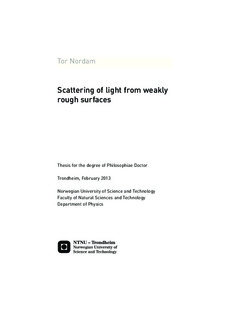| dc.contributor.author | Nordam, Tor | nb_NO |
| dc.date.accessioned | 2014-12-19T13:18:03Z | |
| dc.date.available | 2014-12-19T13:18:03Z | |
| dc.date.created | 2013-02-27 | nb_NO |
| dc.date.issued | 2013 | nb_NO |
| dc.identifier | 608471 | nb_NO |
| dc.identifier.isbn | 978-82-471-4188-5 (printed ver.) | nb_NO |
| dc.identifier.isbn | 978-82-471-4189-2 (electronic ver.) | nb_NO |
| dc.identifier.uri | http://hdl.handle.net/11250/246841 | |
| dc.description.abstract | A formalism is introduced for the non-perturbative, purely numerical, solution of the reduced Rayleigh equation for the scattering of light from two-dimensional penetrable rough surfaces. In the papers included in this thesis, we apply this formalism to study the scattering of p- or s-polarised light from two-dimensional dielectric or metallic randomly rough surfaces, or from two-dimensional randomly rough thin dielectric films on metallic substrates, by calculating the full angular distribution of the co- and cross-polarised intensity of the scattered light.
We present calculations of the mean differential reflection coefficient for glass and silver surfaces characterised by (isotropic or anisotropic) Gaussian and cylindrical power spectra, and find a good match with experimental results, as well as results obtained from another numerical method. We also present a numerical calculation of the Mueller matrix for scattering from rough surfaces, based on the same method.
We investigate the optical phenomena of enhanced backscattering, enhanced forward scattering and satellite peaks. Enhanced backscattering is a well known phenomenon, and is used as one among several indicators of correct results. The phenomenon of enhanced forward scattering has not previously been investigated in two-dimensional systems. We demonstrate its presence, and provide an explanation for why it is qualitatively different from the same phenomenon in one dimension. Regarding satellite peaks, there has been a dispute in the literature, where one group found they should be present in scattering from a thin dielectric film on a metallic substrate, while another group found they should not. We have demonstrated their presence, and shown how the one-dimensional phenomenon of satellite peaks become “satellite rings” in the two-dimensional case.
The proposed method is found, within the validity of the Rayleigh hypothesis, to give reliable results. For a non-absorbing metal surface the conservation of energy was explicitly checked, and found to be satisfied to within 0.03%, or better, for the parameters assumed. This testifies to the accuracy of the approach and a satisfactory discretisation. We also perform a numerical investigation of the range of validity of the reduced Rayleigh equation for scattering from two-dimensionally rough silver and perfectly conducting surfaces.
The advantage of using a numerical solution of the reduced Rayleigh equation, rather than a rigorous numerical method such as the surface integral method, lies in the required computational resources. The main limitation of these methods for considering two-dimensionally rough surfaces are their memory requirements. To calculate the scattering amplitude for a typical system studied in this thesis, by the reduced Rayleigh equation, requires 12 GB of memory. To solve a similarly sized system with a rigorous method requires one or two orders of magnitude more. The limitation of the reduced Rayleigh equation is that it can only be applied to weakly rough surfaces, due to the assumption of the Rayleigh hypothesis. | nb_NO |
| dc.language | eng | nb_NO |
| dc.publisher | Norges teknisk-naturvitenskapelige universitet, Fakultet for naturvitenskap og teknologi, Institutt for fysikk | nb_NO |
| dc.relation.ispartofseries | Doktoravhandlinger ved NTNU, 1503-8181; 2013:47 | nb_NO |
| dc.relation.haspart | Leskova, T. A.; Letnes, P. A.; Maradudin, A. A.; Nordam, T.; Simonsen, I.. The scattering of light from two-dimensional randomly rough surfaces. OPTICAL COMPLEX SYSTEMS - OCS11: 817209, 2011. <a href='http://dx.doi.org/10.1117/12.899304'>10.1117/12.899304</a>. | nb_NO |
| dc.relation.haspart | Nordam, T.; Letnes, P. A.; Simonsen, I.; Maradudin, A. A.. Satellite peaks in the scattering of light from the two-dimensional randomly rough surface of a dielectric film on a planar metal surface. Optics Express. (ISSN 1094-4087). 20(10): 11336-11350, 2012. <a href='http://dx.doi.org/10.1364/OE.20.011336'>10.1364/OE.20.011336</a>. | nb_NO |
| dc.relation.haspart | Letnes, P. A.; Maradudin, A. A.; Nordam, T.; Simonsen, I.. Calculation of the Mueller matrix for scattering of light from two-dimensional rough surfaces. Physical Review A. Atomic, Molecular, and Optical Physics. (ISSN 1050-2947). 86(3): 031803, 2012. <a href='http://dx.doi.org/10.1103/PhysRevA.86.031803'>10.1103/PhysRevA.86.031803</a>. | nb_NO |
| dc.relation.haspart | Nordam, T.; Letnes, P. A.; Simonsen, I.. Numerical simulations of scattering of light from two-dimensional surfaces using the Reduced Rayleigh Equation. . | nb_NO |
| dc.relation.haspart | Nordam, T.; Letnes, P. A; Simonsen, I.. Validityof the Rayleigh hypothesis for two-dimensional randomlyrough metal surfaces,. Proceedings of CCP2012, 2012. | nb_NO |
| dc.relation.haspart | Letnes, P. A.; Nordam, T.; Simonsen, I.. Coherent effects in the scattering of light from two-dimensional rough metal surfaces. Journal of the Optical Society of America A. (ISSN 0740-3232). 30(6): 1136-1145, 2013. <a href='http://dx.doi.org/10.1364/JOSAA.30.001136'>10.1364/JOSAA.30.001136</a>. | nb_NO |
| dc.title | Scattering of light from weaklyrough surfaces | nb_NO |
| dc.type | Doctoral thesis | nb_NO |
| dc.contributor.department | Norges teknisk-naturvitenskapelige universitet, Fakultet for naturvitenskap og teknologi, Institutt for fysikk | nb_NO |
| dc.description.degree | PhD i fysikk | nb_NO |
| dc.description.degree | PhD in Physics | en_GB |
